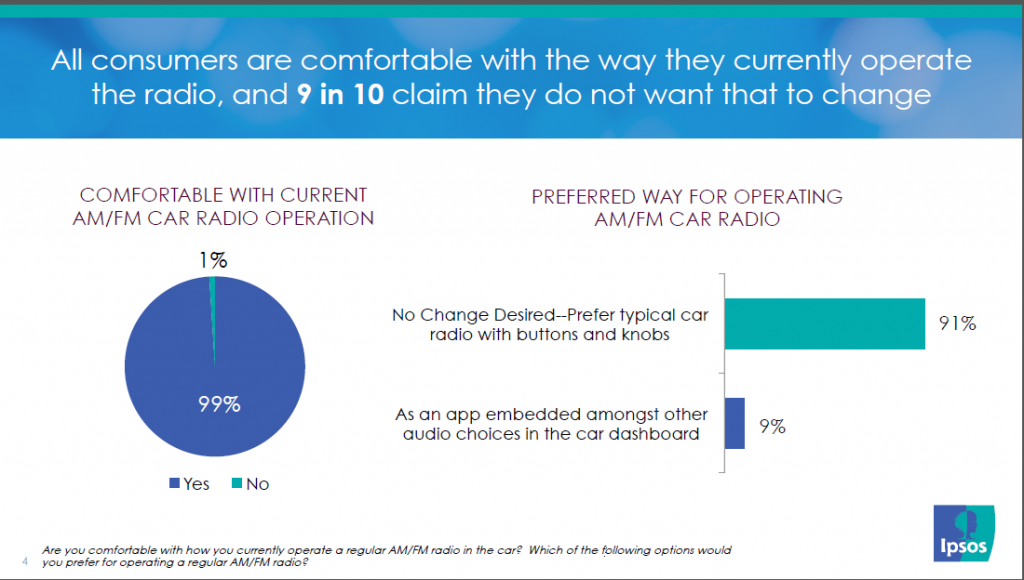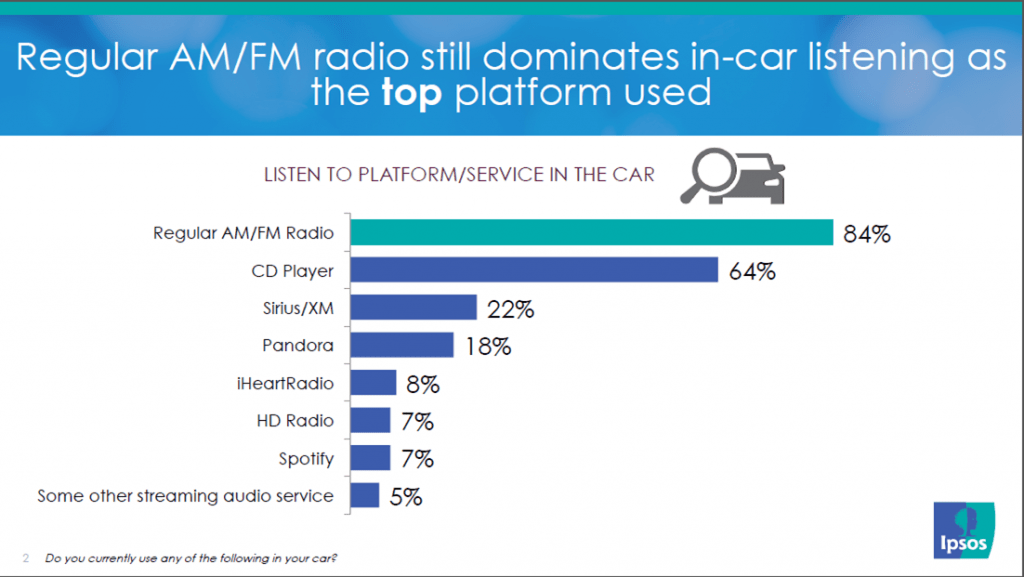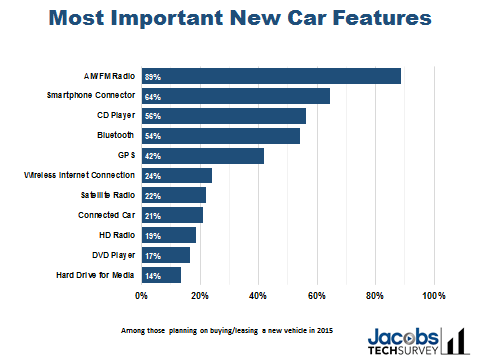Chances are good you saw that story from Forbes last week, strongly showing consumer demand for and usage of the AM/FM radio platform in cars and trucks.
Broadcast radio, a platform? AM/FM radio is a legitimate platform, and according to Forbes contributor Christopher Versace, a new IPSOS survey shows that it’s the dominant choice in cars. Overall, their study reveals that AM/FM radio is the preferred in-car preference with 91%, compared to only 9% opting for an app-based system. Respondents were given an either/or choice, and they overwhelmingly went with old school radio.
In their survey of more than 1,000 Americans 18+, IPSOS also learned than more than 8 in 10 (84%) survey takers listen to AM/FM radio in their cars, while Siriius/XM (22%), Pandora (18%), and Spotify (7%) distantly trail.
Versace’s money quote: “More Americans use AM/FM radio each week than use Facebook.”
And from the research side, Thomas Spinelli, VP with Ipsos MediaCT, noted. “Our studies show that despite all the technological advances we’ve made when it comes to digital listening, the vast majority of Americans still prefer AM/FM radio overall and especially expect it to be a part of their cars – in fact, virtually all said they wouldn’t buy a car without a radio.”
But it’s not just the IPSOS research saying this. Our soon-to-be-released Techsurvey11 echoes this research, reinforcing the ongoing appeal of AM/FM radio in cars. In our survey of more than 41,000 North Americans, we isolated prospective car buyers and asked them to tell us which in-car media features are most important in their new vehicles:
And there it is at the top – nearly nine in ten of those in the market for a new vehicle in their driveways report that AM/FM radio is of greatest importance. While connectivity (smartphone jack, Bluetooth, WiFI, etc.) are becoming more attractive over time, nothing is more desirable and necessary to consumers than broadcast radio.
So how do we explain the disconnect in article after article, and story after story about “connected cars?” If AM/FM radio is in such high demand and celebrates nearly ubiquitous usage, why is there so much noise suggesting that that broadcast radio is an endangered medium in cars? And why are we bothering to put together a third DASH Conference in partnership with Radio Ink this November in Detroit if everything is so copacetic?
It’s simply counter intuitive. Everyone wants broadcast radio in the car and consumers use it regularly. Yet, many talk about how radio’s days are numbered in the car. The paradoxical issue revolves around the notion that while AM/FM radio is considered to be “standard equipment” in new cars, it isn’t what’s bringing people into showrooms. No one walks into a new car dealership and asks about that new Mustang with the AM/FM radio. In fact, most are hungry for newer features they’ve seen advertised or experienced with other people or in rental cars.
The sense of anticipation for new in-car media emanates from the fact that the average vehicle on the road is more than 11 years old. When consumers decide it’s time for a new ride, they have a strong desire for something that is truly NEW.
And that’s where all the talk about smartphone connectivity, Sirius/XM, Pandora, and apps come into play. A new car buyer assumes AM/FM radio will be there. But what they really are revved about is the availability of new media choices, and that’s where these digital options and new media features sweeten the deal.
But even if consumers look forward to a new car with lots of media options, AM/FM is still right there in the “center stack,” right?
Well, when that buyer takes delivery on their new car, the chances are becoming much better than they’ll need instruction. Even the most basic in-vehicle media systems have a lot of moving parts and features that require some explanation and instruction.
 Enter the trainer (often the salesperson) who is tasked with quickly orienting an anxious consumer who simply wants to get in that new car and go.
Enter the trainer (often the salesperson) who is tasked with quickly orienting an anxious consumer who simply wants to get in that new car and go.
And because so many new car buyers are focused on the “what’s new,” the time and attention given to AM/FM radio in these orientation sessions is diminishing. In some cases, it may be difficult for consumers to even find the AM/FM radio, much tune in and preset their favorite stations.
For the radio industry, this is a fork in the road, and a critical inflection point that could very well shape the future of in-car listening levels and preferences for years to come.
We have some amazing data in Techsurvey 11 to show the industry about the “connected car” training process and what it means to radio. And at DASH, we’ll be focusing on the dealership level, and looking for opportunities for local radio stations to become proactive and succeed both on the listening and the sales fronts.
The IPSOS and Techsurvey11 data indicate that all is well for radio and the car. But a deeper look shows that this storied relationship is fragile and very much in flux. The “center stack” is redefining the in-car media experience and that has big-time implications on broadcasters.
In the “connected car” space, too many people are disconnecting the dots.
For more information on DASH 3.0, click here.
- Can Radio Afford To Miss The Short Videos Boat? - April 22, 2025
- Media And Technology In 2025: Believe It Or Not! - April 18, 2025
- In Radio, You Just Never Know - April 17, 2025







Two takeaways here – 1) This research seems to suggest the the Auto industry may be a bit too hip for the room. The solution seems to be marrying an app array with a radio that works the same way they always have. 2) Those numbers aren’t as good as they’re made to sound. Radio has a lot of competition that it didn’t have even a few years ago and while it hasn’t been usurped, in the aggregate it has sapped TSL seriously. My guess is that 12-34 those numbers look a lot worse for radio.
Bottom line is that radio still has some time to retool while people still love it, but they aren’t going to love 1995 media forever. In the words of those infamous HD radio spots, “its time to upgrade”.
I think you’re right on both counts. Radio has a leg up in surveys like this because so many people don’t have satellite or the ability to connect a phone. That said, AM/FM is a lot more popular than many think. And yes, there’s still time, but it’s also moving faster than many think.
Regarding the “12-34 year-old comment,how many 12-16 year-olds drive cars? Furthermore, the American Automobile Club (AAA) would agree with me–the connected car will contribute to more distracted driving crashes. Bottom line: there is a time and a place for everything. Perhaps the auto makers (and the Dash Conference participants) should consider making the connected car controls accessible to back seat passengers–not to drivers.
Barry, thanks for the comment. The automakers are working hard to provide more safety in these vehicles with voice commands and simplifying the technology. But there’s a long way to go.